Popplet is a mind-mapping app, which offers a limitless canvas that lets users capture ideas then organize and connect them in a multitude of ways. It’s no surprise that vocabulary building and Popplet are such a good fit. A language might consist of millions of words – a daunting prospect for the language learner. Fortunately, getting to know each and every word is not how vocabulary building works. The key to understanding a lexicon is to navigate its vastness through its connections. Popplet is the perfect tool for this.
In our previous article, we introduced some ways to teach language learners vocabulary by employing Popplet’s user-friendly features. We hope we gave some indication of Popplet’s potential as an adaptable, effective application for the ESL classroom. Next, we are going to examine more vocabulary building strategies by focussing on:
- Phrasal Verbs
- Popplet Linker
- Popplet Comments
- Adding URLs
- Popplet Presentations
Let’s begin with the words that every English language student loves to hate: phrasal verbs!
Teaching Phrasal Verbs with Popplet – a lesson plan
A single phrasal verb could take up a whole class if you let it. Some “phrasals” have multiple abstract uses, and these definitions aren’t always related. In short – phrasal verbs are considered “difficult”, students tend to “dislike” them, and anything connected to them, including the teacher. Can Popplet make phrasal verbs more popular? Probably not. But what Popplet can do is provide an engaging and effective visual learning experience, complete with memory-jogging connections and presentable archives. All of this might tip the “I hate phrasal verbs” needle just a fraction in the learner’s favor – and the teacher’s! Check out First Certificate student Victor’s come in popplet:
The term “come in” is easily recognizable to most English learners in its literal sense, but like most phrasal verbs, that’s only the tip of the iceberg. Victor’s popplet (which is part of a set) helps reveal the bigger picture. It contains the useful additional information learners need for a deeper understanding:
- Multiple definitions with example sentences
- If the verb is transitive, intransitive, or both
- Whether the verb can be separated or not
- Links to dictionary definitions, other valuable information
- Translations (not visible on the main board) and examples of the verb in the learner’s L1
The above Popplet was created during the following classroom activity, one of the aims of which was to model how to create a phrasal verb template and ultimately an archive of related phrasal verbs:
- First, select the phrasal verb(s) that you want your students to study – “come in, come across, come to….” for example
- Next, create a popplet with the infinitive of the verb at the center. Explain how Popplet works if necessary
- When ready, elicit meanings for the phrasal: students should explain in English but if they respond in their L1, write up these answers along with any other pertinent information they provide
- Create example sentences, this will probably occur in tandem with the previous activity. Make sure all answers are correct (It is unlikely that students will know more than one or two definitions of a phrasal verb, at this point provide the additional meanings with example sentences.)
- Another option is to refer the students to a dictionary: Word Reference is more than adequate, and it functions as a dictionary in that only the base word – “come” in this example – is the reference.
- Continue the activity by having students add the meanings and sentences to their popplets
- Then, add the dictionary, translator or any other useful links they find helpful
- Next, ask students to decide if the verbs are transitive, intransitive or both. Check their understanding of these terms and add the information to the Popplet
- Then, ask students if the phrasal verbs are separable or inseparable – add this information to the Popplet
- Finally, the students can add definitions in their own languages using Popplet Comments. For most, this is helpful for revision, and these translations aren’t immediately visible on the main popplet board so interference is minimal
The result is a visual representation of meaning, which your students can refer to any time they need to. Excellent for revision or when recycling vocabulary in later classes. Learners could also add images or videos, younger learners might even want to draw!
This can be a time-consuming class activity, but so long as students are comfortable with the basic grammar involved, they will find it productive and entertaining. Having students complete these type of popplets for homework is a good way to free up valuable class time. I have found that students often simply copy and paste the dictionary definitions. This is ok, providing we spend some time reviewing their work in class.
Now all the students need is an archive – a space where all their hard work is organized and accessible. This is where Popplet Linker comes in.
Creating Interconnected Vocabulary Popplets with Popplet Linker
Common vocabulary ESL instruction usually follows the pattern of grouping together related words: the home, clothes, business meetings… This helps forge vital connections and increases a learner’s English survival levels. This is what this Food Collocations popplet is all about:
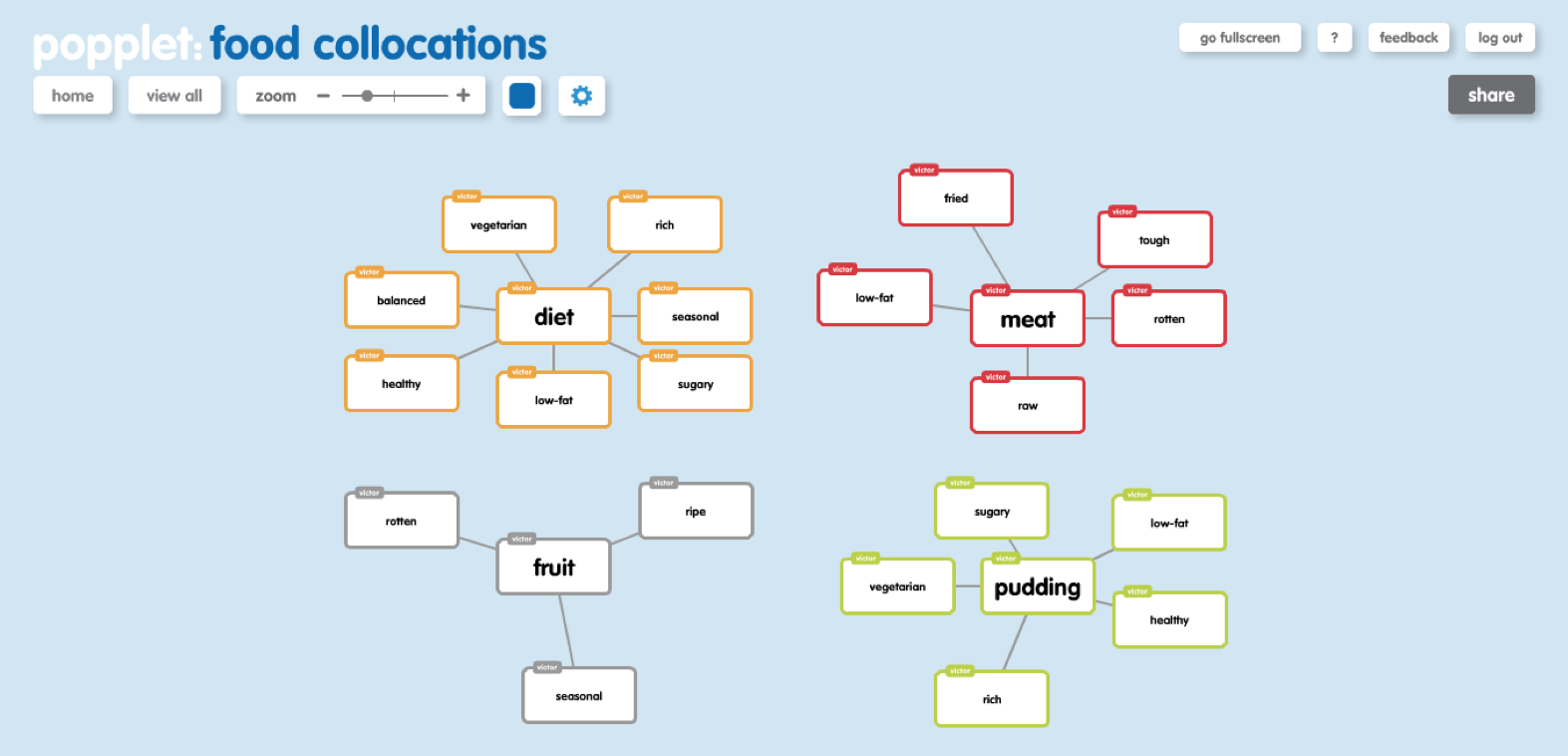
And, this Cambridge First Certificate Science Vocabulary Popplet:
Wouldn’t it be splendid if all of this interconnected vocabulary could be kept together for easy access? With Popplet it can.
Let’s start with our come in phrasal verb popplet from above. There’s no universally correct way to classify phrasal verbs, but using the principal verb, seems sensible enough for most educators:
- Begin by creating a new popplet: aptly named something like “phrasal verbs: come”. It is, of course, empty, but we’ll soon fix that
- Next, click on the blue cog menu, then select popplet linker from the drop-down menu:
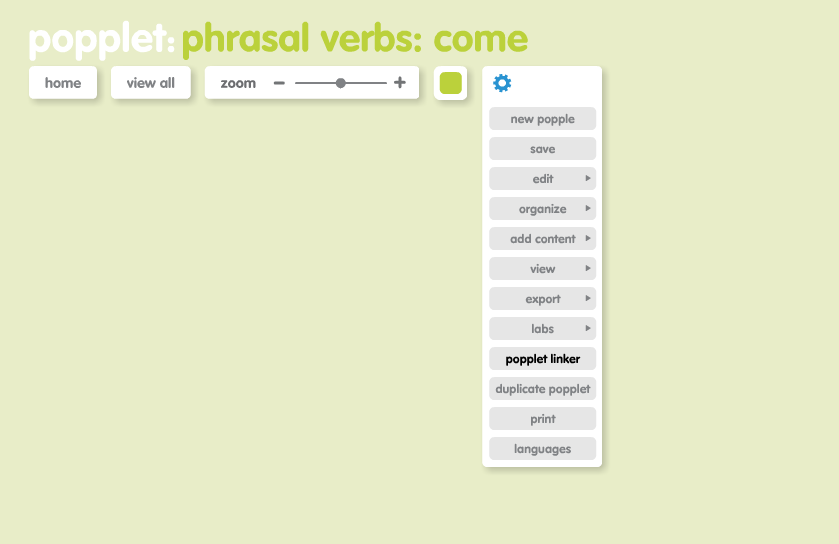
- Then, choose the popplet you want to include in your archive from the menu that appears by double clicking on or dragging it into the new popplet board:
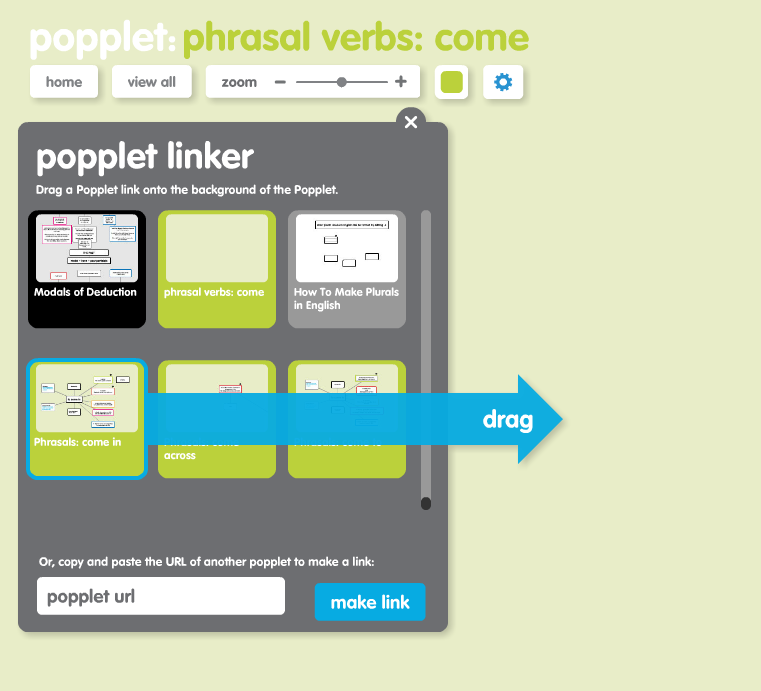
- If all is well, it should look like something like this:
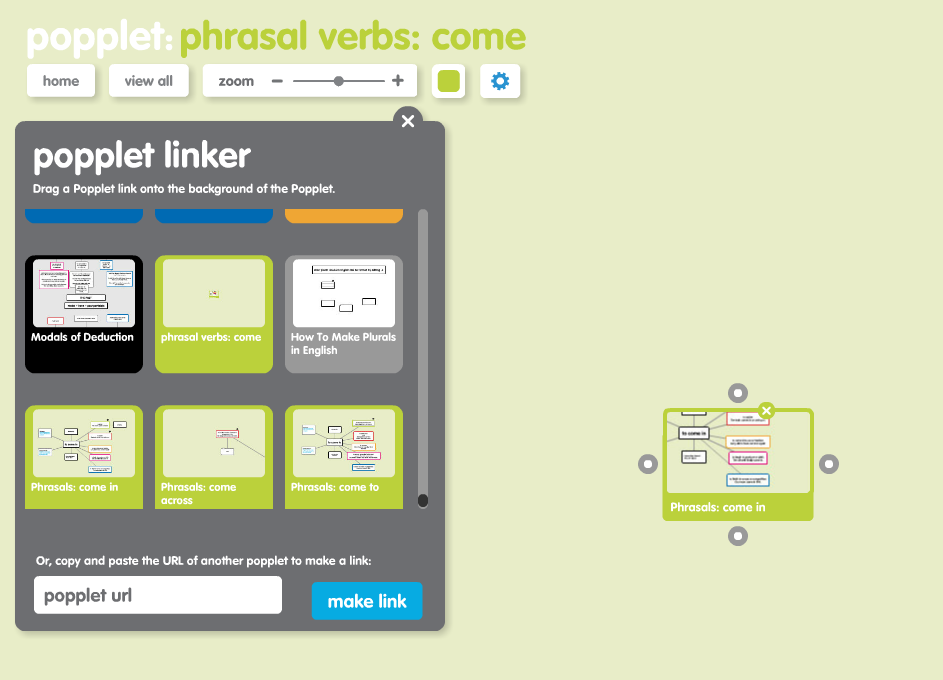
- Repeat for any other popplets that you want to add, and you will eventually end up with all the popplets of your choosing in the same space:
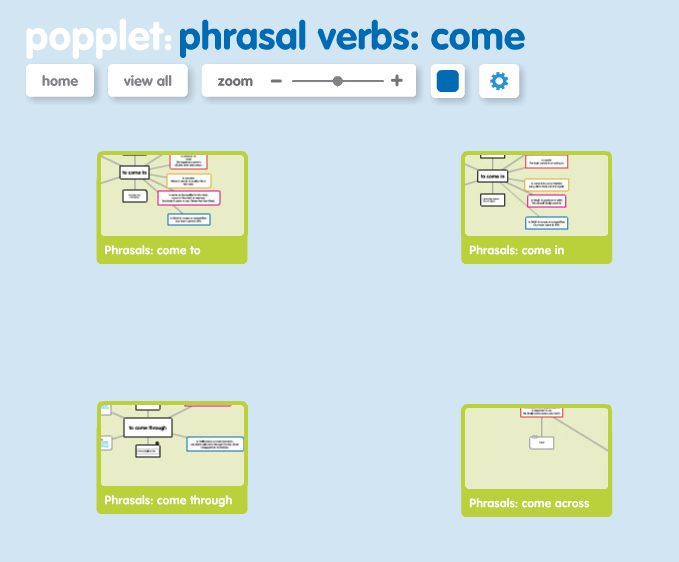
And there you have it, a functional inter-connected vocabulary archive. Indispensable at exam time, for quick reference or for presentations.
By digging a little deeper and adopting a more organic approach. By taking a closer look at patterns and structures, English learners can make the connections which make for more effective language acquisition. Popplet makes it all possible.
Popplet is available on the web, and as an iOS app for the iPad and iPhone. New web users receive ten popplet boards when they sign up for a free account. Be sure to check out Popplet’s reduced rates for School and Class group subscriptions.
If you are a language teacher or learner and you are using Popplet, we would like to hear from you. You can find ideas and share with the Popplet community on Twitter, and on our Facebook page.
The other articles in this Popplet ESL series are:
Popplet Ideas for ESL Teaching
Popplet ESL Activities: An Introduction to Pronunciation
Popplet ESL Activities: Irregular Verb Flash Cards
Popplet ESL Activities: Grammar
Popplet ESL Activities: Vocabulary Building (1)